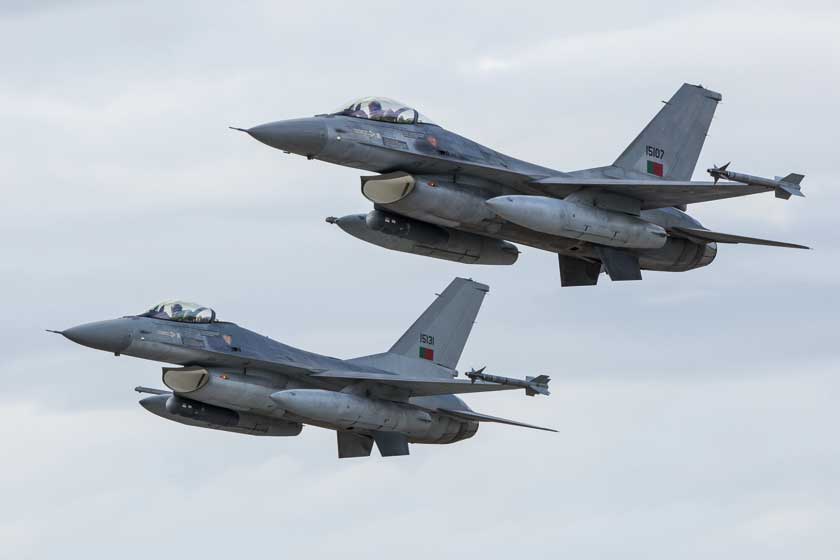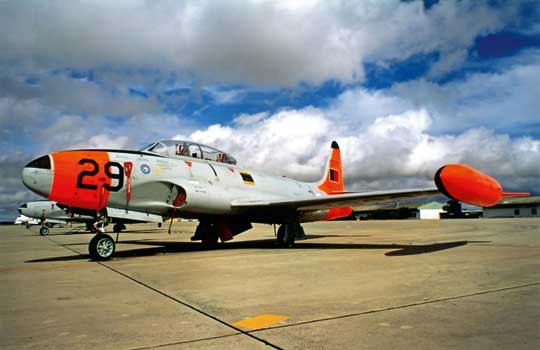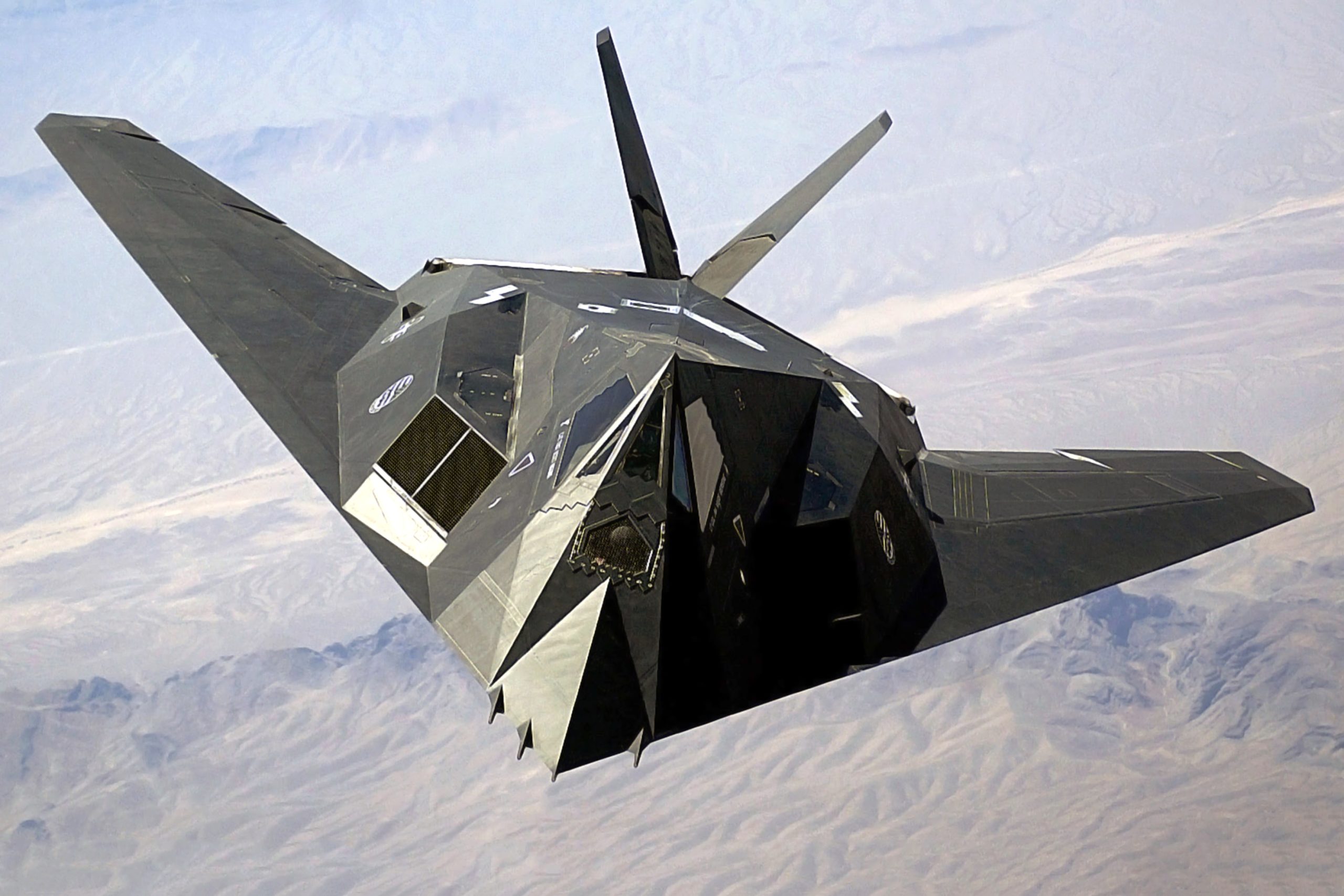Portuguese military aviation part 2

Today, the F-16 is the main FAP fighter. In order to modernize and extend the service life due to financial constraints, about a dozen units were recently sold to Romania.
The first jet aircraft of the Portuguese Air Force were two de Havilland DH.1952 Vampire T.115, purchased in September 55. After commissioning on the basis of BA2, they were used to train fighter pilots with a new type of power plant. The British manufacturer, however, never became a supplier of jet fighters to the Portuguese aviation, as the first American F-84G fighters were accepted into service a few months later. Vampire was used sporadically and was transferred to Katanga in 1962. Then the Swedish SAAB J-29 fighters, which are part of the UN peacekeeping force, destroyed them on the ground.
The first Republic F-84G Thunderjet fighters arrived in Portugal from the United States in January 1953. They were received by the 20th squadron at Ota, which, four months later, was fully equipped with 25 fighters of this type. The following year, 25 Squadron received 84 more F-21Gs; both divisions created Grupo Operacional 1958 in 201. Further deliveries of the F-84G were made in 1956-58. In total, the state of Portuguese aviation received 75 of these fighters, originating from Germany, Belgium, the USA, France, the Netherlands and Italy.

Between 1953 and 1979, the FAP operated 35 Lockheed T-33 Shooting Star trainers in various versions from various sources. The photo shows a former Belgian T-33A, one of the last to arrive at the FAP.
Between March 1961 and December 1962, 25 F-84Gs were received by the 304th squadron stationed at the BA9 base in Angola. These were the first Portuguese aircraft to serve in the African dominions, beginning the aerial aspect of the colonial war. In the mid-60s, Thunderjets still in service in Portugal were transferred to Esquadra de Instrução Complementar de Aviões de Caça (EICPAC). It was one of the last countries to withdraw the F-84G, which remained in service until 1974.
In 1953, 15 Lockheed T-33As entered the Jet Aircraft Training Squadron (Esquadra de Instrução de Aviões de Jacto). The unit was to support the training and conversion of pilots to jet aircraft. It soon became the Esquadrilha de Voo Sem Visibilidade, a stealth training squadron.
In 1955, a separate, 33nd squadron was created on the basis of the T-22A. Four years later it was converted to the Esquadra de Instrução Complementar de Pilotagem (EICP) to convert pilots from T-6 Texan reciprocating trainers to jets. In 1957, the unit was transferred to BA3 at Tancos, the following year it changed its name to Esquadra de Instrução Complementar de Pilotagem de Aviões de Caça (EICPAC) - this time it was given the task of basic fighter pilot training. In October 1959, it was replaced by five more T-33s, this time the T-33AN Canadair, previously used in Canada. In 1960, the unit received two RT-33A, which were used for photographic reconnaissance. In 1961, five T-33AHs were sent to Air Base 5 (BA5) at Monte Real, where they were used to train F-86F Saber pilots. A batch of 10 more T-33s went to Portugal in 1968, and the last aircraft of this type in 1979. In total, the FAP used 35 different modifications of the T-33, the last of which was withdrawn from service in 1992.
The adoption of the F-84G into service allowed Portugal to receive NATO standards and made it possible to carry out tasks in cooperation with allied countries. In 1955, on the basis of five Thunderjets, the Dragons aerobatic team was formed, which three years later replaced the San Jorge group, which was carrying out the program in the same composition; the team was disbanded in 1960.
If at the end of the 50s the Portuguese aviation had a large fleet of relatively modern fighters, then after a few years the combat capabilities of the F-84G were very limited. There was an urgent need for machines that could replace worn-out jet engines. On August 25, 1958, the first US-supplied F-2F Saber landed at BA86 at Ota. Shortly thereafter, the 50th squadron was equipped with fighters of this type, which was renamed the 51st and transferred at the end of 1959 to the newly opened BA5 in Monte Real. In 1960, more F-86Fs joined No. 52 Squadron; In total, the FAP at that time had 50 machines of this type. In 1958 and 1960, another 15 F-86Fs were delivered to the unit - these were former Norwegian fighters supplied by the United States.
In October 1959, as part of the search for a successor to the T-6 Texan, the British Hunting Jet Provost T.1 jet trainer was tested at the BA2 base in Sintra. The car was flying with Portuguese markings. Tests were negative and the aircraft was returned to the manufacturer. In addition to jet engines, in 1959 the Portuguese aviation included an additional six Buk C-45 Expeditor aircraft (earlier, in 1952, seven aircraft of this type and several AT-11 Kansan [D-18S] were added from naval aviation to units).
African colonies: preparation for war and escalation of the conflict
In May 1954, the first batch of 18 Lockheed PV-2 Harpoon aircraft transferred to the United States under the MAP (Mutual Assistance Program) arrived in Portugal. Soon, they received additional anti-submarine equipment (SOP) at the OGMA factories. In October 1956, another unit equipped with the PV-6S was created in VA2 - the 62nd squadron. Initially, it consisted of 9 cars, and a year later, several additional copies, some of which were intended for spare parts. A total of 34 PV-2s were sent to the Portuguese military aviation, although initially they were intended for use in patrol tasks, the escalation of the conflict in Africa led to the fact that they were assigned completely different tasks.
